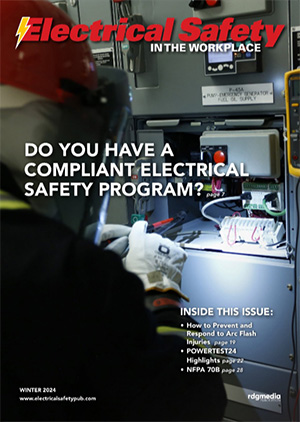How to Properly Care for Rubber Insulating Gloves, Sleeves, and Blankets to Extend Use and Safety
By Richard Rivkin, Contributor
 OSHA, NFPA, and the ASTM standards mandate the use of rubber insulating products when even the smallest probability of contact (with 50 volts AC or higher) exists. These rules affect nearly all industrial workplaces, as every single facility (not just utilities, electrical contractors, telecom companies, municipalities, and electrical co-ops) has a need for electrical safety, and failure to comply can result in heavy fines, serious injury, and even death. Moreover, OSHA and ASTM standards also require regular inspection of in-service electrical protective equipment in order to maintain compliance and ensure the products’ safety and integrity. Fortunately, there are safety measures and solutions that you can easily employ to help prevent injuries, citations and penalties, including visual inspection and proper storage of rubber insulating gloves, sleeves, and blankets.
OSHA, NFPA, and the ASTM standards mandate the use of rubber insulating products when even the smallest probability of contact (with 50 volts AC or higher) exists. These rules affect nearly all industrial workplaces, as every single facility (not just utilities, electrical contractors, telecom companies, municipalities, and electrical co-ops) has a need for electrical safety, and failure to comply can result in heavy fines, serious injury, and even death. Moreover, OSHA and ASTM standards also require regular inspection of in-service electrical protective equipment in order to maintain compliance and ensure the products’ safety and integrity. Fortunately, there are safety measures and solutions that you can easily employ to help prevent injuries, citations and penalties, including visual inspection and proper storage of rubber insulating gloves, sleeves, and blankets.
Inspection Helps Ensure Protection
ASTM F496-20 in-service standards require the regular inspection of in-service electrical protective equipment in order to maintain compliance and ensure the products’ safety and integrity when exposed to a wide range of voltages. All rubber insulating equipment should be thoroughly inspected prior to use. Common problems to look for include the following:
- Cracking and Cutting – Prolonged folding or compressing can cause this type of rubber damage
- UV Checking – Storing in areas exposed to prolonged sunlight causes UV checking
- Chemical Attack – Oils and petroleum compounds can cause swelling of the rubber
- Avoid Folding – The strain on rubber at a folded point is equal to stretching the rubber to twice its length
- Snags – Wood, metal splinters, and other sharp objects can snag or tear rubber
- Physical Damage – Rope burns, deep cuts, and puncture hazards are cause for rejection
 Visually inspecting rubber gloves and sleeves identifies physical, chemical, or ozone damage. Direct light is recommended because it enhances the ability to see surface imperfections on the rubber. Inflating the gloves with air (or otherwise stretching the surface) helps identify age and ozone damage, as well as other physical damage such as snags, rope burns, deep cuts, and punctures. A portable, mechanical inflator may be used in the field to enhance the inspection of the glove and identification of any damage. Simply affix the glove to the inflator and pump it up to view any damage to the glove that is not otherwise visible unless viewed after inflating.
Visually inspecting rubber gloves and sleeves identifies physical, chemical, or ozone damage. Direct light is recommended because it enhances the ability to see surface imperfections on the rubber. Inflating the gloves with air (or otherwise stretching the surface) helps identify age and ozone damage, as well as other physical damage such as snags, rope burns, deep cuts, and punctures. A portable, mechanical inflator may be used in the field to enhance the inspection of the glove and identification of any damage. Simply affix the glove to the inflator and pump it up to view any damage to the glove that is not otherwise visible unless viewed after inflating.
Otherwise, if a portable inflator is not available, use a rubber glove inspection tool or roll the glove cuff tightly to trap air inside. Expand the gloves no more than 1.50 times their normal size for Type I non-ozone-resistant rubber. Listen for escaping air to detect holes. Then, apply pressure to areas of the glove to inspect for escaping air. Repeat the procedure again with the rubber gloves turned inside out.
The use of two-color rubber insulating gloves can also aid in the identification of problems in that any damage to the outer layer enables the inner, contrasting color to be seen.
Do not forget that, with very few exceptions, rubber insulating gloves must always be worn with leather protector gloves manufactured in compliance with ASTM standard specification F696. Leather protector gloves themselves offer no protection against high or low voltage but are intended to be worn over rubber insulating gloves to protect them from cuts, abrasions, and punctures. Therefore, do not forget to inspect leather protector gloves every day as well, since dirt and grime can hide damage. Be sure to also inspect the leather protector gloves for embedded wires or metal shavings that could puncture or damage the rubber gloves.
When inspecting rubber sleeves, make sure to examine them along the edge as they are rolled. Rolling will stretch the sleeve along the edge, making cuts, tears, and ozone cutting more visible. Repeat this process again with the rubber sleeve turned inside out.
Roll rubber insulating blankets to properly inspect them in order to locate scratches, tears, abrasions, snags, corona cutting, or age cracking. Make sure to roll the blankets two times on each side, with the second roll at a right angle to the first. Immediately remove blankets from service that show any signs of damage.
Store to Use More
 Proper storage extends the service life of the rubber insulating equipment. When not in use, store rubber goods in a suitable container such as a canvas bag designed specifically for that purpose.
Proper storage extends the service life of the rubber insulating equipment. When not in use, store rubber goods in a suitable container such as a canvas bag designed specifically for that purpose.
Never fold rubber insulating gloves. Folds and creases strain rubber and cause it to crack from the ozone prematurely. Store rubber gloves with the fingertips up in the right sized bag or roll up, and never force more than one pair into each bag. Avoid storing the gloves inside out, which can also cause strain and promote ozone cutting. It is permissible, according to ASTM F496, to store rubber gloves inside of their leather protectors, but exercise good judgment. If the leather gloves are wet or damp from working in inclement weather, then remove them from the rubber gloves to allow them to dry. Also remove the leather protectors so that the rubber gloves and leather protectors can both be inspected before the start of the next workday. Try to store in a dry and cool location away from sources of ozone and direct sunlight.
There are several field storage options available for rubber insulating sleeves, including sleeve roll-ups, canvas sleeve bags, and combination bags for storing gloves and sleeves together. Field storage of rubber insulating blankets shall be in a bag, box, container, or compartment that is designed for and used exclusively for them. Refer to ASTM F1236 standard guide for visual inspection of electrical protective rubber products for additional information.
Test for the Ultimate Safety Success
In summary, damage to many types of personal protective equipment (PPE) can be apparent when the equipment or devices are inspected by the user. However, rubber insulating products are more complicated. It is important to note that the reduction in effectiveness can be caused by a variety of factors that may not be readily apparent to the user, and improper use of rubber insulating equipment can be a matter of life and death. The best way to ensure that rubber goods are safe for their intended use is to have them periodically retested at their proof test voltage by a qualified test lab. If you do not have the equipment needed to perform these electrical tests, there are independent testing facilities that can perform the acceptance and in-service testing on behalf of end users. The retest process includes thoroughly cleaning the products, visually inspecting them for physical damage, performing dielectric testing at the rated test voltage, and marking and packing the accepted products for return shipment. Products passing the inspection and test procedures can then be safely returned to service. When selecting a test lab for use, make sure that it is a NAIL-accredited test lab. NAIL stands for National Association of Independent Laboratories for Protective Equipment Testing (www.nail4pet.org). It incorporates the only Laboratory Accreditation for the electrical equipment test labs program in North America. NAIL4PET helps develop uniformity in testing and works in close association with the American Society of Testing Materials (ASTM International).
Richard A. Rivkin is President and Chief Executive Officer of Saf-T-Gard International, Inc., a privately held family-owned and operated global supplier of industrial safety products based in Northbrook, Illinois. Founded in 1936 as Latex Glove Company, Saf-T-Gard carries on the tradition that was started more than 80 years ago: bringing customers the products, training and service they need to keep employees safe in the workplace. Saf‑T‑Gard actively operates the Voltgard® Test Lab, one of the largest, independent, NAIL4PET-accredited test labs for rubber insulating products in the United States (www.saftgard.com).
Share on Socials!
The Crucial Role of Licensed Engineers in Performing Arc Flash Studies: State Regulations vs. NFPA 70E
How to Establish an Electrically Safe Work Condition
Understanding Arc Flash PPE
Leaders in Electrical Safety
• Aramark
• Bowtie Engineering
• Enespro
• Ericson
• I-Gard Corporation
• IRISS
• KERMEL, INC.
• Lakeland Industries
• MELTRIC Corporation
• National Safety Apparel
• National Technology Transfer
• Oberon
• Saf-T-Gard
• SEAM Group
Subscribe!
Sign up to receive our industry publications for FREE!







